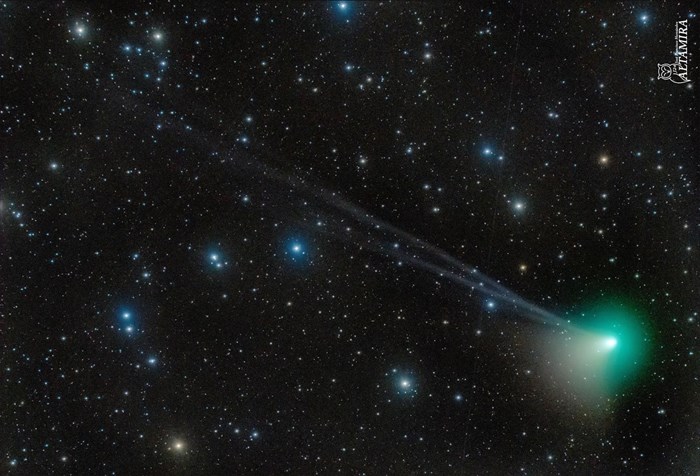
Three blue ion tails extend to the upper right, likely the result of a variable solar wind on ions ejected by the icy comet nucleus. The comet's white dust tail is visible to the upper left and much shorter. The green glow is the comet's coma, caused by glowing carbon gas.
Image Credit: SUBMITTED/Jose Francisco Hernández
January 12, 2023 - 1:00 PM
A comet is nearing the earth and it may become visible to the naked eye from Kamloops and the Okanagan.
NASA is reporting C/2022 E3 will reach its closest point to the sun, Jan. 12, and the best time for viewing will be when it closest to the earth on Feb. 1.
After the comet reaches its closest point to the sun, “it may become visible even without binoculars to northern observers with a clear and dark sky,” according to the space agency.
Some skywatchers are excited by the green glow, which can currently be observed through a telescope.
However the comet is not guaranteed to produce a visual phenomenon for those without powerful instruments.
“The brightness of comets is notoriously unpredictable, but by Feb. 1, C/2022 E3 could become only just visible to the eye in dark night skies,” NASA reported last month.
Colin Taylor, a physics professor at Thompson Rivers University, is also warning sky gazers that the comet may not look very flashy.
“Sometimes they have all these predictions about comets being very bright, that don’t come to pass,” he said. “You can never be sure until it actually happens.”
For anybody in Kamloops or the Okanagan hoping to witness C/2022 E3, Taylor recommends getting away from light pollution, and said binoculars will bring out much more detail, such as the colour and streaks.
When C/2022 E3 reaches its closest point to earth on Feb. 1 – for the first time in 50,000 years – it will be approximately 42 million kilometres away, according to space.com. The best time of day to observe the comet is during the early hours of the morning before sunrise.
To contact a reporter for this story, email Dan Walton or call 250-488-3065 or email the editor. You can also submit photos, videos or news tips to the newsroom and be entered to win a monthly prize draw.
We welcome your comments and opinions on our stories but play nice. We won't censor or delete comments unless they contain off-topic statements or links, unnecessary vulgarity, false facts, spam or obviously fake profiles. If you have any concerns about what you see in comments, email the editor in the link above.
News from © iNFOnews, 2023